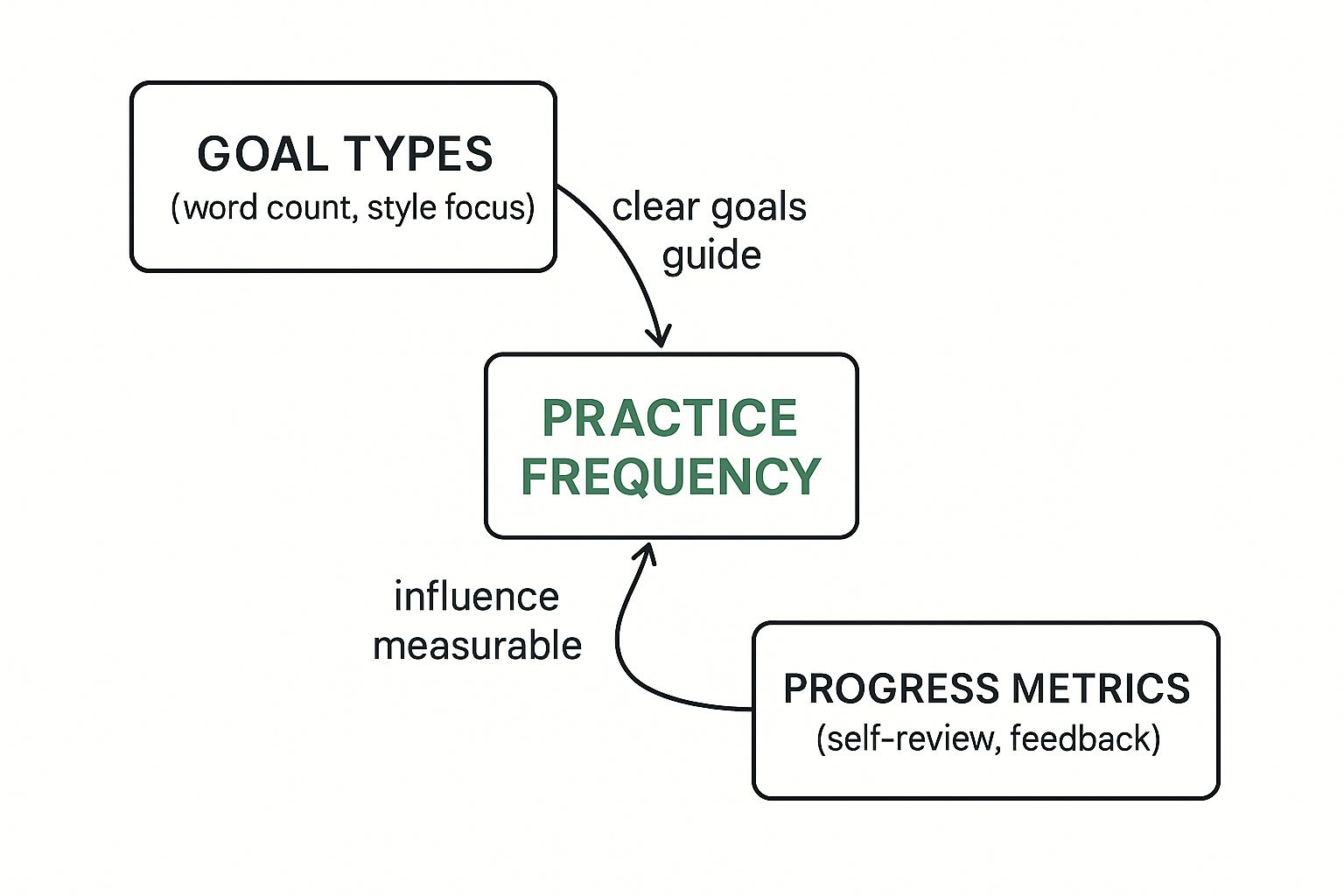
How to Improve Writing: Tips to Boost Your Skills Today
June 17, 2025
Finding Your Voice When Everything Sounds Generic
Let's be honest, most writing advice throws rules at you instead of helping you discover your own style. You hear about avoiding passive voice, varying sentence structure, and worshipping the grammar gods. Sure, these are important, but they don’t solve the core problem: sounding like everyone else. It’s like having a Stradivarius but no idea how to play it.
This is the quicksand so many writers, especially new ones, get stuck in. They try mimicking their favorite authors or following formulas, only to end up with writing that feels empty and impersonal. They're chasing "good" writing, not their writing. If you're struggling with this, you might find this article on improving writing skills helpful.
Uncovering Your Authentic Style
So, how do you escape the generic trap and find your true voice? It all begins with understanding that your perspective is unique and valuable. Your experiences, observations, and thoughts are your own – no one else sees the world quite like you do. That's the bedrock of a voice that truly connects.
Think about how you tell a story to a friend. You naturally use specific details, maybe throw in some humor or emotion, and highlight what you find interesting. That’s your natural rhythm, your perspective shining through. That's the magic we want to capture in your writing.
Practical Techniques for Finding Your Voice
How do you bring that natural storytelling magic onto the page? Here are a few things I've found helpful:
- Freewriting: Set a timer for 10-15 minutes and just write. Don't stop, even if it's nonsense. This helps silence your inner critic and lets your natural flow take over.
- Journaling: Regular writing, even just for yourself, helps you develop your voice and gives you a treasure trove of material to draw on later.
- Experiment with different styles: Play around! Try different tones, sentence structures, and vocabulary. Don’t be afraid to break the rules and see what clicks.
Grammarly can be a surprisingly useful tool here. It catches errors, of course, but it can also give you insights into your writing style.
This screenshot shows Grammarly's interface, highlighting its tone detector and clarity suggestions. These are gold for refining your style and making your writing sound more natural.
Overcoming the Fear of "Nothing to Say"
So many writers worry they have nothing interesting to offer. But it's not about having earth-shattering ideas; it’s about sharing your take on them. 73% of readers connect more with content that feels authentic and personal, even if the topic isn't new.
Focus on how you see things, not on trying to impress with facts or expertise. Trusting your unique perspective is what makes your writing stand out. That confidence is what resonates with readers.
The Writing Mechanics That Actually Move Readers
Forget those dusty old grammar rules about never starting a sentence with "and" or "but." Let's talk about what really makes writing sing. Think about your favorite books—they pull you in, right? There's a rhythm, a momentum that keeps you turning pages. That's the magic we're after.
Compelling writing, no matter the topic, relies on subtle techniques that hook readers without them even knowing why. It's like a secret handshake between you and your audience.
This infographic below illustrates a crucial point: defined writing goals (like aiming for concise language or a specific word count) directly influence how often you practice and, ultimately, how much you improve. Having a target in mind focuses your efforts and makes progress feel real.

The infographic clearly demonstrates that specific goals inform your practice frequency and provide a way to measure your progress, whether you're evaluating yourself or getting feedback from others. It underscores the importance of knowing where you're going with your writing. And speaking of direction, professional writers understand how to use sentence variation to create that compelling rhythm we talked about. They break grammar rules for impact – strategically, not accidentally.
Mastering the Art of Sentence Variation
Want to know one of the most effective ways to level up your writing? It's mastering sentence variation. Monotonous sentences are like a long, straight road—functional, but boring. Varying your sentence length and structure adds those interesting twists and turns that keep readers engaged.
Short, punchy sentences create a sense of urgency. Longer, more complex sentences offer context and depth. The trick is finding the right balance. Too much variation can feel chaotic, so aim for a natural ebb and flow, like a conversation.
This screenshot from Hemingway Editor shows the power of simplicity and clarity.

Hemingway Editor highlights complex sentences and adverbs, encouraging you to simplify your writing for better readability. It's a fantastic example of how clear, concise language can supercharge your writing's impact.
And that brings us to another key element: paragraph structure. Choppy or rambling paragraphs disrupt the flow and leave readers confused. Each paragraph should have a clear focus, with sentences building on each other logically.
To help visualize this, let's look at a comparison of different writing techniques and their impact on the reader.
To help visualize this, let's look at some fundamental writing techniques and how they impact the reader experience.
| Writing Technique | Weak Implementation | Strong Implementation | Reader Experience |
|---|---|---|---|
| Sentence Variation | Repetitive sentence structure; monotonous rhythm. | Varied sentence length and structure; creates a natural rhythm. | Weak: Reader gets bored. Strong: Reader stays engaged. |
| Paragraph Structure | Disorganized; lacks clear topic sentences; rambles. | Focused; each paragraph develops a single idea; logical flow. | Weak: Reader gets confused. Strong: Reader easily follows the argument. |
| Word Choice | Generic and vague language; lacks impact. | Specific and vivid language; creates imagery and emotion. | Weak: Reader loses interest. Strong: Reader feels connected. |
This table highlights how seemingly small changes in your writing technique can drastically alter how a reader experiences your work. By focusing on strong implementations of these core elements, you can create writing that truly resonates.
Smart Technology Integration Without Losing Your Soul
The world of writing is buzzing about AI. It's tempting to dive in headfirst, expecting miracles. But I've seen plenty of writers end up with generic, robotic content that way. The real magic happens when you use AI to enhance your creativity, not replace it. Here's how I approach it.

This screenshot shows the Jasper.ai interface. It's a popular AI writing assistant, packed with templates and options. While these tools offer a starting point, the real work begins when you take over. I find it's best to use these tools strategically. AI can be fantastic for brainstorming or busting through writer's block. I've used it to generate outlines or get a rough first draft down.
But then I get to work refining and personalizing. Relying solely on AI? That's a recipe for lifeless, predictable writing.
Choosing the Right AI Assistant
Here's the thing: not all AI writing assistants are the same. Some are great for short, punchy social media posts. Others handle longer articles better. My advice? Experiment! Find what clicks for you. And don't be afraid to mix and match. You might use one tool for brainstorming and another for editing, playing to each one's strengths.
Embracing Grammar Checkers and Editing Tools
Tools like Grammarly and ProWritingAid are lifesavers for catching those sneaky typos and grammar errors. But – and this is a big but – don't become overly reliant on them. They're assistants, not editors-in-chief. I've seen them flag perfectly good sentences as passive voice when it was a stylistic choice. Use these tools to highlight potential problems, but trust your own judgment. That’s how you keep your voice authentic.
Maintaining Your Authentic Voice in the Age of AI
It's fascinating to see how technology is changing writing. By 2025, countries like China, India, and Singapore are projected to lead in AI writing adoption – 67%, 61%, and 59%, respectively. That's incredible! It's driven by government support and the growing need for efficient content creation. Globally, AI writing assistants are transforming how we produce content, offering increased productivity and new creative avenues. Discover more insights about AI writing statistics.
But remember this: technology is a tool, not a dictator. Your unique voice is your superpower. Use AI to support and enhance your writing, but never let it overshadow your perspective and style. Find the balance. Leverage technology while staying true to yourself. That’s how you keep your writing fresh, engaging, and undeniably yours.
Why Professional Writers Swear by Enhancement Software

This image of ProWritingAid shows how clean and user-friendly these tools can be. See all those analysis options? Grammar, style, readability, overused words – it’s all there. They give you a complete picture of your writing's strengths and weaknesses.
These programs are way more powerful than your average spell checker. They offer deep analysis and specific suggestions for improving clarity, conciseness, and overall impact.
For example, they can point out repetitive sentence structures, flag too much passive voice, and even suggest stronger vocabulary. It's like having a personal writing coach in your computer, helping you refine your work and develop a sharper eye for detail.
Power Tools for Words
This isn't about letting software write for you. It's about using smart tools to level up your own skills. Think of it like a carpenter with power tools. The tools don’t replace skill—they amplify it, making the work more precise and efficient. Speaking of helpful resources, you might find these Professional Writing Tips useful.
This increasing reliance on writing enhancement software reflects a bigger trend: integrating technology to improve writing across the board. The market for these tools is expected to hit $0.84 billion in 2025, a 13.6% jump from 2024.
The table below illustrates this growth and the factors driving it.
To understand the increasing investment in writing enhancement software, let's take a look at the market trends.
Writing Enhancement Software Investment Trends
| Year | Market Value (Billions) | Growth Percentage | Primary Adoption Drivers |
|---|---|---|---|
| 2024 | 0.74 | - | Growing demand for high-quality content |
| 2025 | 0.84 | 13.6% | Increased focus on clear communication and plagiarism detection |
| 2026 (Projected) | 0.96 | 14.3% | Expanding adoption in business, education, and publishing |
| 2027 (Projected) | 1.10 | 14.6% | Integration with other productivity tools and AI advancements |
As you can see, the market is experiencing significant growth, driven primarily by the demand for clear, effective, and original writing. This trend is expected to continue in the coming years, with further advancements in AI and integration with other tools further fueling growth. Discover more insights about writing enhancement software market growth.
Collaboration and Efficiency
These tools are also invaluable for collaboration. Many platforms have built-in features for real-time co-editing, feedback integration, and version control. This streamlines the editing process, making it much easier for teams to work together on bigger projects while maintaining consistency and quality.
This is especially important in fast-paced environments where efficiency is key. From polishing sentences to catching those easy-to-miss typos, these platforms provide a safety net that frees writers to focus on their ideas and creative flow. They can spend more time crafting compelling stories and less time sweating the small stuff.
Writing That Gets Results in a Noisy Digital World

This screenshot shows a ContentKing dashboard, a tool that keeps an eye on your website content. It’s a good reminder of how important it is to track what’s working and what's not. Knowing how your writing performs is key to improving.
This isn't about writing something beautiful that gathers dust in a corner of the internet. It's about writing that actually does something – writing that makes people take action.
Think about all the content vying for your attention – emails, social media, blog posts. It's a lot. So how do you break through and make your writing stand out?
Understanding Your Audience
One crucial element is really understanding your audience. Forget broad demographics like “millennials” or “Gen Z.” Dig deeper. Think about their worries, their goals, their frustrations. What are their hopes and fears?
Knowing your audience's pain points allows you to address their actual needs through your writing. This creates genuine connection.
For example, imagine you're writing about a productivity app. Don’t just list features. Tell a story about how the app helped someone, like a stressed-out entrepreneur who finally regained control of their schedule. That's how you resonate with readers.
The Power of Storytelling
We’re wired for stories. They help us connect, build trust, and understand complicated ideas. Weaving narratives into your writing, even in a business context, makes your content memorable. It makes an impact. For more on crafting great stories, check out our guide on how to write better essays.
Analyzing What Works
Another tip? Look at successful content in different fields. Why do some articles go viral while others flop? Examine headlines, structure, and tone. Figure out what makes readers tick. This gives you a blueprint for more engaging writing.
Content writing statistics emphasize the importance of quality and engagement. High-quality content is projected to significantly boost engagement and drive conversions, especially looking ahead to 2025. Interestingly, AI is even being used to refine this process. Want to delve deeper? Discover more insights about content writing statistics.
Measuring Your Impact
Finally, don’t just hit “publish” and disappear. Track your results. Look at website traffic, social media shares, email clicks. Use that data to get better. This data-driven approach shows you what resonates with your audience and how to craft writing that truly gets results.
Building a Personal Writing System That Actually Works
Every writer who consistently cranks out great work has a system. It’s a personalized approach, probably nothing like what you’d find in a writing manual. It's built around their life, not some perfect, unattainable routine. So, let’s ditch the generic advice and build a writing system that actually works for you.
Designing Your Personalized Process
First, forget all the "shoulds." Don't worry about what other writers tell you is the "right" way. Focus on your reality. When do you have the most energy? Are you a morning person or a night owl? Do you like structure, or do you prefer to go with the flow? Your writing system needs to fit your natural rhythms, not fight them.
Personally, I'm a morning person. My brain is at its best then – ideas are flowing, and I can get a good chunk of work done before the day's distractions kick in. That's my sweet spot, so my system is built around it. I protect that morning writing time fiercely.
This screenshot shows how I use Notion to organize my writing. I track deadlines, brainstorm, and keep all my resources in one place. Having a central hub like this keeps me focused and prevents that scattered, unproductive feeling. For others, evenings might be the best time to write. The point is, experiment and find what truly works for you.
Adapting to Your Life and Preferences
There are so many different ways to plan, draft, and revise. Some writers plan every detail meticulously before they even start writing. Others just dive in and let the words guide them. Neither way is "better"—it’s about finding what clicks for you.
Talking with other writers, I've discovered some incredibly unique approaches. One friend uses mind maps and voice notes to catch ideas on the go. Another swears by index cards and a physical corkboard to organize their thoughts. The key is to try different methods and see what resonates.
Tracking Progress and Maintaining Momentum
Tracking your progress is motivating, but it's easy to get fixated on word counts and deadlines. Find a healthy balance. A simple spreadsheet or notebook can help track your writing, but don't let it become a stressor. The goal is a sustainable system.
One helpful tip I picked up from a fellow writer is to break big projects into smaller, more manageable pieces. Instead of focusing on finishing a whole article, aim for 500 words a day, or maybe just completing one section. This keeps the momentum going and prevents that overwhelmed feeling. Having a system for revisions also helps – it makes editing much less daunting.
Finally, remember that your writing system should evolve with you. What worked last year might not work today. Be open to trying new things, refining your process, and constantly learning. Improving your writing is a journey, not a destination.
Your Personal Writing Breakthrough Plan
Let's be honest, transforming your writing isn't some magical overnight process. It's more like building a personalized training plan, like prepping for a marathon. Generic advice won't cut it; you need a strategy built around your strengths, weaknesses, and writing goals.
Prioritizing for Maximum Impact
The first step is an honest self-assessment. Where do your writing struggles really lie? Is it crafting those killer opening lines? Grappling with grammar gremlins? Or maybe it's finding your unique voice that resonates with readers. Identifying your weak spots helps you prioritize. You don't need to fix everything at once – focus on the areas that will have the biggest payoff.
For example, if clarity is a constant battle, concentrate on tightening up your sentence structure and choosing words that pack a punch. If connecting with readers feels like a struggle, put your energy into developing your voice and weaving in compelling stories. This targeted approach gives you more bang for your buck and gets you results faster.
Setting Realistic Timelines and Milestones
Next up, let's talk goals. Remember, Rome wasn't built in a day, and your writing won't magically transform overnight either. Break down your big-picture goals into smaller, more manageable milestones. Instead of aiming to "become a better writer" (which is pretty vague), try setting a goal to write for 30 minutes every day or to finish one blog post each week. These small victories build momentum and keep you going.
Tracking your progress is essential. A simple spreadsheet, a dedicated notebook, or even a notes app on your phone can work wonders. Log your writing sessions, finished projects, and any feedback you receive. This creates a tangible record of your improvement, which is seriously motivating. Plus, it helps you spot patterns and refine your approach over time.
Building Accountability and Staying Consistent
Accountability is huge, but ditch the guilt trips – they rarely work. Find a system that genuinely motivates you. Maybe it's joining a writing group, partnering with a writing buddy, or connecting with a mentor who can offer support and guidance. Sharing your goals and progress with others adds a layer of responsibility and keeps you on track.
Consistency is key, too, but watch out for burnout. Don't try to do too much too soon. Start small and gradually ramp up your writing time or project scope as you gain confidence. Think of it as a marathon, not a sprint. Pace yourself, celebrate your successes, and don’t hesitate to take breaks when you need them.
Focusing on Real Progress, Not Perfection
Finally, let go of the need for perfection. It's a creativity killer. Focus on making progress, not on churning out flawless prose. Every writer makes mistakes, even the seasoned pros. Look at each piece of writing as a chance to learn and grow, not a judgment of your abilities. Embrace the messy process, play around with different techniques, and don’t be afraid to take risks. That's where the real magic happens.
Want to unlock your writing potential and create content that's engaging and genuinely human? Give Natural Write a try. It's a free platform that helps you transform AI-generated text into something natural and compelling. Think of it as your secret weapon for creating content that resonates with readers and bypasses AI detection tools.


